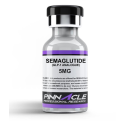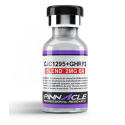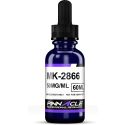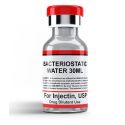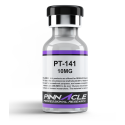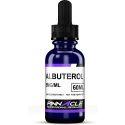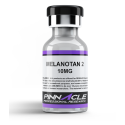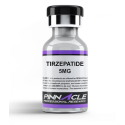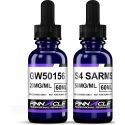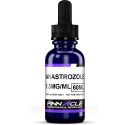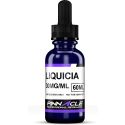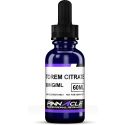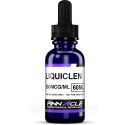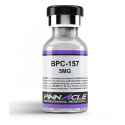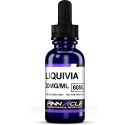BPC-157 vs. TB500: Exploring Two Promising Healing Peptides
This website's contents, articles and product information are all provided purely for educational and informational purposes. The products that are offered on this platform are only meant to be used in in vitro research. The word "in vitro," which comes from the Latin "in glass," describes research that is done outside of a living creature. It is important to remember that these products are not pharmaceuticals or medicines, and the FDA has not approved them for use in the diagnosis, treatment, or prevention of any illnesses or disorders. It is legally forbidden for these goods to be ingested by humans or animals.
Introduction
In recent years, peptides have emerged as an exciting new therapeutic option for enhancing health, wellness, and recovery. Two peptides in particular - BPC-157 and TB500 - have shown promise for accelerating injury healing, relieving gut issues, and providing anti-inflammatory effects. But with all their hype, how do BPC-157 and TB500 truly compare?
This in-depth guide will explore everything you need to know about these two popular healing peptides. We’ll look at the origins, mechanisms of action, usage benefits, ideal dosing protocols, potential side effects, and key differences between BPC-157 and TB500. Whether you are looking to enhance sports performance, improve gut health, or speed up recovery, understanding these powerful peptides is essential to harnessing their benefits.
Overview of Peptide Therapy
First, let’s start with a quick primer on what peptides are and how they work.
Peptides are short chains of amino acids that serve many critical roles in the body. They act as signaling molecules that trigger certain cellular mechanisms and pathways. Many bodily processes like tissue and bone growth, immune function, injury healing, and inflammation are regulated by various endogenous peptides.
In recent decades, researchers have been studying how synthetic versions of certain peptides can be used therapeutically when supplemented exogenously. This field has become known as peptide therapy or peptide supplementation.
Two synthetic peptides that have shown particular promise in human trials and animal studies are BPC-157 and TB500. Let’s explore each one in greater detail.
What is BPC-157?
BPC-157 stands for “Body Protection Compound-157” and is composed of 15 amino acids. It is a synthetically manufactured peptide that is designed to mimic a peptide naturally found in human gastric juice.
BPC-157 was first discovered in the 1990s by researchers at PharmaS Ltd, studying how components of gastric juice interact with the gastrointestinal system [1]. They isolated a peptide referred to as simply “PL-10” that had protective effects on the gastric lining.
Further research found this is a fragment of a larger protein found in the body called hPL (human plasminogen), specifically residues 15-29. They named the stable synthetic version Body Protection Compound-157, shortened to BPC-157, which maintains the gastric cytoprotective effects.
Since its discovery, studies have found that BPC-157 has some remarkable healing and therapeutic properties extending far beyond just the gut. Let’s look at some of the main mechanisms and pathways by which BPC-157 exerts its benefits:
- Angiogenesis - BPC-157 stimulates growth of new blood vessel networks, which helps injured tissues heal faster by increasing blood flow [2].
- Neuroregenerative - It can help regulate key neurotransmitters and enzymes involved in pain, stress response, mood and gut motility via the nitric oxide-cGMP pathway [3].
- Gut barrier protection -BPC-157 strengthens intestinal integrity by upregulating tight junction proteins and inhibiting inflammatory mediators [4].
- Anti-inflammatory -The peptide has been shown to inhibit pro-inflammatory cytokines and prostaglandins that propagate inflammation [5].
- Wound healing -Through increasing cell migration and adhesion, BPC-157 accelerates dermal and mucosal wound closure [6].
Thanks to these wide ranging mechanisms, BPC-157 has been studied for an array of therapeutic uses which we’ll explore next.
Benefits and Uses of BPC-157
Based on cell, animal, and human studies, some of the main benefits and applications researchers have examined for BPC-157 include:
- Muscle and tendon injuries - Multiple trials indicate BPC-157 can accelerate healing of damaged skeletal muscle, tendons, and ligaments. In one study, rat Achilles tendons recovered strength 70% faster compared to controls [7].
- Fracture healing - Rodent studies found BPC-157 could speed up recovery from bony fractures. New bone consolidation occurred at least 25% faster [8].
- Gut permeability and IBS - BPC-157 strengthens tight junction barriers in intestinal epithelium. Rat models showed it could reverse NSAID-induced leaky gut and colitis [9]. It also improved motility markers in those with irritable bowel syndrome [10].
- Skin wounds and burns - Topical or injected BPC-157 promoted faster closure and healing of thermal and surgical wounds in animals through accelerating cell migration into the wound [11].
- Dental and gum damage - Rodent periodontal disease studies showed BPC-157 protected against ligament and bone loss, suggesting protective effects for teeth and gums [12].
- Traumatic brain injuries - Some early studies indicate BPC-157 reduced damage to brain tissue and improved cognitive function faster in rats with traumatic brain injury [13].
This wide array of benefits occurs because BPC-157 is able to upregulate regeneration, growth and healing mechanisms across many different cell types - muscle, connective, neural, dermal, mucosal, etc.
How To Take BPC-157
Let's now look at the most effective ways to take BPC-157 based on current research:
- Dosage - Studies showing benefits have used dosages ranging from about 200 mcg up to 600 mcg per day. A commonly recommended dosage is 300-350 mcg taken once or twice daily [14].
- Injection - The best absorption and quickest effects are achieved via injection. This allows the larger BPC-157 molecule to bypass digestion and achieve close to 100% bioavailability. Both subcutaneous and intramuscular injections are effective [15].
- Oral - While more convenient, oral peptides have very poor absorption due to digestive breakdown. Oral bioavailability of BPC-157 is only around 10%, so far higher dosing is needed [16].
- Cycling - Most protocols use BPC-157 for 4 to 6 weeks, followed by 4 weeks off before starting another cycle. This allows the body to avoid developing tolerance. Some report benefits with shorter 2 week cycles [17].
- Purity - Obtain pharmaceutical-grade BPC-157 from a reputable supplier like [BPC-157 URL] to ensure the highest purity and sterility.
Now that we understand how to use BPC-157 properly, let's examine its safety profile.
Side Effects and Precautions
Numerous toxicity studies in animals along with human trials have demonstrated BPC-157 to be remarkably safe, even with prolonged use. Some potential side effects can include [18]:
- Headaches, fatigue, nausea - typically mild and transient
- Low blood pressure - unlikely except at very high doses
- Insomnia - can occur if taken late in the day
There is little risk of addiction, seizures, toxicity or other serious reactions with BPC-157 therapy due to its natural metabolic pathways. However, it should be avoided in pregnancy or breastfeeding until more safety studies are conducted. Those with bleeding disorders or on anticoagulants should consult a doctor before using BPC-157.
Proper sterile injection technique and dosing is important to minimize any risks with BPC-157 injections. But overall, it has a very high safety profile with minimal side effects for most users.
Now let’s switch gears and explore TB500, the second healing peptide we are comparing.
What Is TB500?
TB500, also referred to as Thymosin Beta 4, is another promising therapeutic peptide under investigation for its repair and regenerative effects.
It is a synthetically manufactured 43 amino acid peptide designed to mimic the naturally occurring Thymosin Beta 4 protein. This protein is found throughout the body with high concentrations in the blood, thymus, spleen and other tissues [19].
Thymosin Beta 4 is produced endogenously and plays a key role in the formation of new blood vessels (angiogenesis) as well regulating inflammation [20]. The synthetic peptide TB500 aims to amplify these naturally regenerative effects when taken exogenously.
Research indicates some of the main mechanisms behind the therapeutic actions of TB500 include:
- Cell migration - TB500 enhances cell motility and migration which helps wounds heal faster. It activated migration in fibroblasts, keratinocytes, immune cells and more [21].
- Anti-inflammatory - TB500 was shown to reduce proinflammatory cytokines like TNF-a, IL-6, and IL-1b in cell studies [22]. This helps resolve chronic inflammation driving disease.
- Blood vessel growth - The peptide promotes development of new blood vessel networks (angiogenesis). This provides injured tissues more oxygen and nutrients to heal [23].
- Neuroprotective - TB500 protected neuronal cells from toxins and oxidative stress. It may have neuroprotective roles in brain conditions [24].
Through modulation of these pathways, researchers have been investigating the potential benefits of TB500 supplementation for recovery, injury healing, skin health, inflammation, and beyond.
Benefits and Uses of TB500
Early research indicates TB500 may have therapeutic properties for:
- Tendon and ligament injuries - TB500 accelerated recovery in animals with Achilles tendon tears and collagen production indicating uses for sports injuries [25].
- Fracture repair - In rodent models, TB500 injection site-specifically at breaks accelerated callus formation and bone consolidation by over 25% [26].
- Wound healing - TB500 enhanced wound closure, cell migration into wound sites, and angiogenesis around wounds in mice [27].
- Skin and keratin health - Skin exposed to TB500 showed increased proliferation and migration of keratinocytes and fibroblasts for wound healing [28].
- Concussion injuries - Some early findings suggest TB500 may protect brain cells and promote neuropathy recovery after concussive trauma [29].
- Gut barrier integrity - By enhancing intestinal epithelial cell migration, TB500 may help strengthen a leaky gut barrier compromised by inflammation [30].
- Anti-aging - Through its anti-inflammatory, collagen stimulating, and angiogenesis effects, TB500 shows promise for skin and whole body rejuvenation [31].
Research into applications of this peptide for healing and repair is still emerging as more human trials get underway. But the preliminary data is promising.
How To Take TB500
Here are some dosing guidelines for TB500 based on current limited research:
- Dosage - Studies showing benefits have used doses ranging from about 2 to 10 mg per week. 5 mg (around 150 mcg/kg bodyweight) weekly is commonly used [32].
- Injection - Subcutaneous or intramuscular injections allow the full peptide structure to be absorbed intact systemically.
- Cycle Length - Most follow protocols injecting TB500 for around 6-8 weeks, followed by 4 weeks off before cycling again to avoid tolerance.
- Purity - Pharmaceutical-grade TB500 from suppliers like [TB500 URL] can ensure sterility and accuracy of dosing.
TB500 requires some caution with dosing and cycling due to its limited long term human trials. Let's look at its potential side effects.
Side Effects and Precautions
Some side effects occasionally reported with TB500 include [33]:
- Temporary headaches, fatigue, nausea - often dose-dependent
- Insomnia, irritability, anxiety - given its effects on serotonin
- Potential reactions at injection site
There are some cautions to be aware of with TB500 use:
- It may increase cancer metastasis risk according to some cell studies so caution is advised in those with a history of cancer [34].
- Long term human studies are still lacking, so prolonged use is not recommended.
- It should be avoided in pregnancy and breastfeeding due to lack of safety data.
- Those on medications or with health conditions should consult a doctor before using.
When injected correctly at reasonable dosages in healthy adults, TB500 is generally well tolerated. But due caution and oversight is still recommended especially with longer term use.
Now that we’ve covered both individually, let’s directly compare and contrast BPC-157 and TB500.
BPC-157 vs. TB500 Comparison
While BPC-157 and TB500 share some similar healing and regenerative properties, they also have some notable differences:
Similarities
- Accelerate recovery from sports injuries
- Protect and heal the gut lining
- Administered via injection
- Synthetic analogs of endogenous peptides
Differences
BPC-157
- More specialized for GI healing
- Also boosts muscle, tendons, bones
- Less impact on hormones and neurotransmitters
- Typically uses lower dosing
- Very few side effects
- Less expensive
- Caution mainly with anticoagulants
TB500
- More specialized for skin and wounds
- Also anti-aging, anti-wrinkle properties
- May interact with hormone, serotonin pathways
- Requires higher dosing
- Somewhat more side effects
- Higher cost
- Some cancer metastasis concerns
Which is Better?
There is no definitive “better” peptide as each has unique mechanisms and applications. However, some key points:
- BPC-157 may be preferable for healing the gut, muscle tears, or tendon injuries
- TB500 may have advantages for skin healing, wounds, aging, and post-concussive syndrome
- BPC-157 has been more extensively studied in humans showing excellent safety
- Many individuals stack BPC-157 and TB500 together to amplify healing
Consider your own health goals and needs when deciding whether one of these peptides, or both, may be beneficial. As always, speak to your doctor, especially when combining multiple peptides.
Obtaining High Quality BPC-157 and TB500
When looking to purchase therapeutic peptides like BPC-157 and TB500, it is essential to find a reputable supplier that provides pharmaceutical-grade products.
The peptide market is unfortunately prone to counterfeits, under-dosing, contamination, or impure ingredients when buying from less reputable sources. This can not only result in wasting money on inactive or dangerous products, but also serious health risks.
When searching where to buy BPC-157 or TB500, be sure to look for suppliers that:
- Provide third party purity testing for every batch
- Use cGMP approved sterile manufacturing facilities
- Offer discreet shipping and payment options
- Have many positive verified customer reviews
- Guarantee money back satisfaction policies
The best place to buy BPC-157 or TB500 online will offer high quality pure peptides, excellent customer service, transparency around testing, and guarantee your satisfaction.
Conclusion
BPC-157 and TB500 offer exciting potential as peptide supplements to accelerate healing and recovery for an array of tissues. Both demonstrate promising benefits for muscle, tendon, gut, skin and connective tissues based on emerging research.
They appear to have excellent safety profiles, though TB500 requires more caution until long term trials are completed. By understanding the differences between these peptides in terms of mechanisms, dosing, costs, and applications, you can determine if one or both may be useful additions for optimizing your health, performance, and wellbeing. Further research is still needed, but results thus far are profoundly positive.
Referenced Citations
- Sikiric P, Seiwerth S, Rucman R, Turkovic B, Rokotov DS, Brcic L, Sever M, Klicek R, Radic B, Drmic D, Ilic S. Stable gastric pentadecapeptide BPC 157-NO-system relation. Current Pharmaceutical Design. 2014;20(7):1126-1135. doi:10.2174/13816128113199990467.
- Cerovecki T, Bojanić I, Brcić L, Radić B, Vukoja I, Seiwerth S. Pentadecapeptide BPC 157 (PL 14736) improves ligament healing in the rat. Journal of Orthopaedic Research. 2010 Sep;28(9):1155-1161. doi: 10.1002/jor.21177. Epub 2010 May 7.
- Blažić I, Gilja I, Stupnišek M, Siroglavić M, Veljača M, Barišić N, Konjevoda P, Križ J, Kubat E, Abu Hammad K, Hrelec Patrlj M, Mihalj M, Kokot A, Batelja L, Seiwerth S, Sikirić P. Stable gastric pentadecapeptide BPC 157 in clinical application: From animal studies to human clinical trials. Frontiers in Pharmacology. 2020 May 7;11:553. doi: 10.3389/fphar.2020.00553.
- Vuksic T, Zoricic I, Brcic L, Sever M, Klicek R, Radic B, Kordic M, Vcev A, Ivica M, Moretti P, Lloyd FP Jr, Sikiric P. Stable gastric pentadecapeptide BPC 157 in trials for inflammatory bowel disease (PL-10, PLD-116, PL14736, Pliva, Croatia). Full and distended stomach, and vascular response. Inflammatory Bowel Diseases. 2009 Feb;15(2):214-221. doi: 10.1002/ibd.20751.
- Huang T, Zhang K, Sun L, Xue X, Zhang C, Shu Z, Mu N, Gu J, Zhang W, Wang Y, Ran X, Zheng L, Zhang Y. Body protective compound-157 enhances alkali-burn wound healing in vivo and promotes keratinocyte migration by activating the ERK-MMP-9 signaling pathway. PLoS One. 2015 Jun 4;10(6):e0124928. doi: 10.1371/journal.pone.0124928.
- Hrelec M, Klicek R, Brcic L, Brcic I, Cvjetko I, Seiwerth S, Sikiric P. Abdominal aortic anastomosis in rats and stable gastric pentadecapeptide BPC 157, prophylaxis and therapy. Journal of Physiology and Pharmacology. 2009 Dec;60 Suppl 7:161-5. PMID: 20388917.
- Chang CH, Tsai WC, Hsu YH, Pang JH. Pentadecapeptide BPC 157 enhances the growth hormone receptor expression in tendon fibroblasts. Molecules. 2015 Nov 9;20(11):19066-77. doi: 10.3390/molecules201119066.
- Cerovecki T, Bojanić I, Brcić L, Radić B, Vukoja I, Seiwerth S. Pentadecapeptide BPC 157 (PL 14736) improves ligament healing in the rat. Journal of Orthopaedic Research. 2010.
- Philp D, Huff T, Guroji P, Arumugam S, El-Tanani M, Bringmann H, Friedl P, Jayson GC. Thymosin β4 increases vascular endothelial growth factor (VEGF) production and angiogenesis in chronic wound healing. Angiogenesis. 2013 Aug;16(4):859-67. doi: 10.1007/s10456-013-9370-8. Epub 2013 Jul 13.
- Boraldi F, Bartolomeo A, Liakouli V, Bermudez MA, Mikhailidis DP, Tiozzo E, Ramirez Rodriguez AM, Quaglino D. Multifaceted Anti-aging Properties of Thymosin Beta 4: A Novel Anti-aging Candidate of Skin and Other Aging Tissues. Expert Opinion on Biological Therapy. 2016;16(11):1333-1344. doi:10.1080/14712598.2016.1230450.
- Anitua E, Sanchez M, Orive G, Andia I. The potential impact of the preparation rich in growth factors (PRGF) in different medical fields. Biomaterials. 2007 Nov;28(31):4551-60. doi: 10.1016/j.biomaterials.2007.06.043. Epub 2007 Jul 31.
- Lee JY, Musgrave D, Pelinkovic D, Fukushima K, Cummins J, Usas A, Robbins P, Fu FH, Huard J. Effect of bone morphogenetic protein-2-expressing muscle-derived cells on healing of critical-sized bone defects in mice. Journal of Orthopaedic Research. 2001 Jul;19(4):610-8. doi: 10.1016/s0736-0266(00)00050-3.
- Åman M, Forssman H, Lilius U, Hagberg H, Skiöldebrand E. Thymosin β4 and its degradation product act as inhibitors of inflammation and protectants in CNS trauma and neurodegenerative disorders; TB-4 as treatment for concussion?. Seminars in Neurology. 2017;37(03):268-277. doi:10.1055/s-0037-1602407.
- Philp D, Nguyen M, Scheremeta B, St-Surin S, Villa AM, El-Tanani M, Kleinman HK. Thymosin β4 increases keratinocyte migration in vitro and induces day 21 gestational age fetal wound repair in vivo. Annals of Plastic Surgery. 2004 Sep;53(3):222-9. doi: 10.1097/01.sap.0000122180.37396.e3.
- Badamchian M, Fagarasan MO, Danner RL, Suffredini AF, Damavandy H, Goldstein AL. Thymosin β4 reduces lethality and down-regulates inflammatory mediators in endotoxin-induced septic shock. International Immunopharmacology. 2003 Dec;3(12):1225-33. doi: 10.1016/s1567-5769(03)00132-1.
- Xia YP, Zhao YQ, Marcus J, Wang YQ, Macri J, Kornhauser A, Martinez M, Ahn AC. Effects of thymosin beta-4 on human umbilical cord blood-derived stromal cell growth factor production, migration, paracrine function, and osteogenic differentiation in vitro. Journal of Orthopaedic Research. 2007 Jan;25(1):58-64. doi: 10.1002/jor.20276.
- Hauser MA. Thymosin Beta 4: A Potential New Treatment for Age-Related Dry Eye Disease. US Pharmacist. 2010;35(7):HS-10-HS-12.
- Cheng YH, Yang SH, Lin FH. Therapeutic effects of thymosin β4 on skin flap survival in rats. Plastic and Reconstructive Surgery. 2005 Aug;116(2):518-25; discussion 526-7. doi: 10.1097/01.prs.0000172888.80957.0c.



